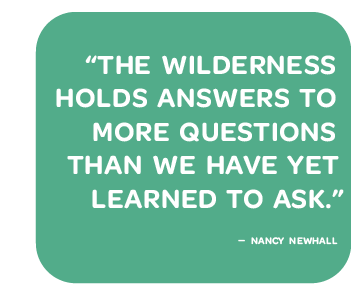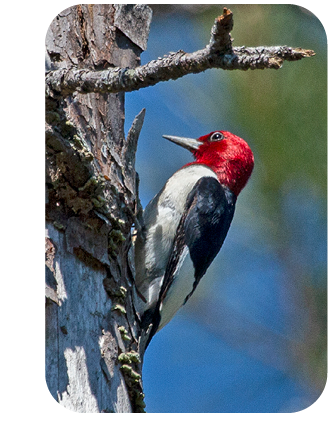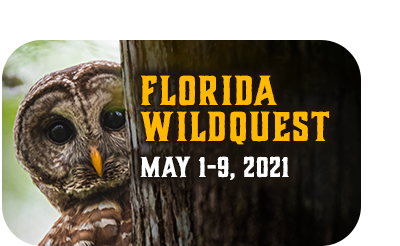
In wild Florida, pines tower above swaths of palmettos. Cypress knees rise out of rich, dark waters. Windswept coasts give way to rivers and lakes brimming with life. In wild Florida, hungry waterbirds dip in and out of the salt marsh in search of fish. Tortoises dig slowly through sandy soil. Black bears roam the forests in search of nuts and fruit.
|
This is the Florida known to people who arrived here more than 10,000 years ago. It’s the Florida that can be found on the 6 million acres that make up our state’s Wildlife Management Areas today. And while only small pockets have remained truly untouched over the centuries, even the parts of these lands used to raise cattle or timber are being restored or managed in their natural state—and are open to Florida residents and visitors for exploration, discovery and family fun!

Studies show time in nature benefits children and adults. It improves physical and mental health and reduces stress. But over time fewer of us are connecting with the places where wild Florida thrives — and the past year has challenged these connections even further.
Now more than ever, we need nature. Florida’s wilderness offers a place for us to safely overcome the fatigue of virtual life and forge the social and emotional connections our minds and bodies need to thrive.
|
Where can you find wild Florida? Odds are it’s closer than you think. You may find pieces of Florida’s natural heritage—from families of sandhill cranes and flocks of songbirds to tangles of ancient Spanish moss—right in your backyard. But venture a bit further and you’re bound to find yourself near the wild lands managed by the Florida Fish and Wildlife Conservation Commission.
In 1941, the State of Florida purchased a huge tract of land just north of Fort Myers, now known as Fred C. Babcock/Cecil M. Webb Wildlife Management Area. What began with one 19,200-acre property in south Florida evolved into a thriving statewide system of natural habitat.
 |
|
Today you can find a Wildlife Management Area (WMA) to visit near most every major metropolitan area and throughout rural Florida. At your local WMA, you’ll step off the beaten path and discover the habitats of red-headed woodpeckers, fox squirrels, gopher frogs, kingsnakes and all the rest of Florida’s amazing native plants and animals. |

Florida WildQuest
Exploring some of the wildest areas in Florida does take some planning, but the Florida Fish and Wildlife Conservation Commission (FWC) is here to help. From May 1 to May 9, 2021, the FWC is hosting Florida WildQuest, a unique scavenger hunt experience for players of all ages on our 47 lead WMAs.
Grab your mobile device and join your family and friends as we bring the wilderness to life with scavenger hunt missions designed to help you discover some of the best spots to see wildlife and enjoy the outdoors. While you play, you’ll be learning all about the plants, animals and history of Florida’s WMAs.
Are you ready to go on a WildQuest? Follow these steps to adventure:
|
-
Find It: Find your local lead Wildlife Management Area. You can use the Wildlife Management Area entrance finder interactive map or find an alphabetical list at https://myfwc.com/recreation/lead/. Note that several Wildlife Management Areas require entrance fees and some are closed to vehicles.
-
Map It: Familiarize yourself with a map of the area you plan to visit. Some areas have trail maps and recreation guides available on their website under “Planning Your Visit.” All areas have road maps in their regulations brochure.
-
Charge Up: Make sure that your mobile device is charged. Not all areas may have mobile coverage but you’ll be able to take pictures for your scavenger hunt missions and submit them later. Visit floridanaturetrackers.com for instructions on how to join a WildQuest.
-
Be Safe: Stay on marked roads and trails. If you plan to be out for more than a day, let someone else know where you’re going. Before you enter a trail, be sure it fits your skill level and the distance you’re prepared for.
-
Pack Smart: It gets hot out there and there are no vending machines in the wilderness. Check the weather before you go and pack your water, sunscreen and snacks!
-
Snap a Pic: Most areas have a kiosk at the main entrance with a welcome sign that includes a map and important reminders for visiting the area. When you see this sign, be sure to take a picture for reference. Grab a recreation guide if one is available at the kiosk.
-
Say Hi! The staff at Wildlife Management Areas love Florida’s wilderness. If you see a staff person be sure to say hello and ask them about the area. They know all the best spots to see wildlife! When interacting with staff and other visitors outdoors, masks should be worn if social distancing guidelines (6 feet) cannot be met.
One more thing to remember! When you visit and support a Wildlife Management Area, you aren’t the only one who reaps the benefits. All of the animals and plants you see are thriving because of these wild places where the natural habitat of Florida is protected and restored. Your support helps us keep these habitats healthy, so people can enjoy Florida’s wilderness for generations to come.
We can’t wait for you to join us on a Florida WildQuest! See you out there, adventurers
|